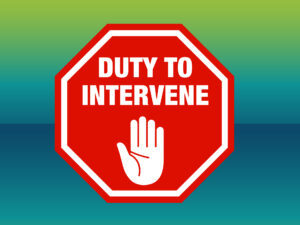Duty to Intervene: Converging Public and Policing Priorities
Posted
March 21, 2022
Share:
A frequent point of debate surrounding alleged misconduct caught on video is the nature and extent of a fellow officer’s duty to intervene. To a member of the public viewing a news report or social media video of these types of events, the perceived lack of intervention in what appears to be clear misconduct can create confusion and further an emotional response to videos of these events. Despite common public perception, rarely are these instances of indifference on the part of multiple officers but rather part of a complex ecosystem of factors including but not limited to inadequate training, culture, and seniority.
 This article takes a high-level look at the duty to intervene in law enforcement: how we got here, what the current state of mandates are, and how agencies are responding. Future articles will look at the facets of this issue in greater detail.
This article takes a high-level look at the duty to intervene in law enforcement: how we got here, what the current state of mandates are, and how agencies are responding. Future articles will look at the facets of this issue in greater detail.
What is duty to intervene?
Duty to intervene regulations require an officer who witnesses misconduct or excessive use to “interrupt” the event using words. Laws vary between states, municipalities, and jurisdictions but generally, they require that an officer intercedes in circumstances where misconduct or excessive force might cause harm to a suspect or member of the public. In many cases, these regulations complement duty to report regulations requiring officers to report excessive force or misconduct to superior officers, internal affairs, or other relevant bodies.
From mid-2020 to the present day, there’s been a wave of state-level legislative efforts crafted in reaction to public calls for increased transparency and accountability in the wake of high-profile policing incidents. Duty to intervene requirements have been visible and prevalent aspects of these efforts. The perception that officers witnessed excessive force and did not intervene was a significant driver of the public outrage that sparked protests around the country and world which, in many cases, led to legislation altering or enhancing duty to intervene requirements. Since 2020, 13 states have passed legislation mandating a duty to intervene – in addition to countless municipalities and agencies creating their standards for intervention.
A Complex Issue
While legislative fixes satisfy public demand for movement on accountability, they leave much of the issue’s complexity to agencies and regulators to tackle. Often intervening in instances of misconduct isn’t an easy task and there are barriers to officers simply “stepping in” when the need arises. Recent media analysis coupled with a paper from the International Association of Chiefs of Police (IACP) identifies some of these barriers:
Chain of command: Many departments operate with a chain of command structure similar to that of the military. These structures can often implicitly or tacitly discourage questioning a superior officer, making it potentially challenging to step in to interrupt actions covered under duty to intervene mandates.
Fear of retaliation: There is a perception that doing something that may cause another officer trouble, whether with internal affairs or another outside regulatory body, can lead to retaliation. This can look like being passed over for promotion or a desired assignment or being ostracized within an agency.
Insufficient training: Intervening usually isn’t as simple as putting oneself “in the middle” of an instance of potential misconduct or excessive use of force. In many of these instances, emotions are running high, and direct appeals to reason or physical restraint may not be the most effective tactics. A growing area of law enforcement training is seeking to address this knowledge gap and build an understanding of what effective intervention looks like.
Training to Intervene
Training for intervention, like other training seeking to address structural issues, is more than just imparting a set of procedures – it instead seeks to build on already present and positive cultural elements within an agency. In 2014, The New Orleans Police Department (NOPD) developed and deployed the Ethical Policing is Courageous (EPIC) peer intervention training program. According to former Commissioner Michael S. Harrison, the program emphasizes a cultural shift away from intervention being viewed as disloyal and instead of being considered as loyalty “on the front end,” characterizing the approach as “let’s let me help you not make this mistake in the first place.
Since the program was enacted, NOPD has shown a decline in use-of-force complaints. While it is likely multiple factors have contributed to these declines in adverse events, the signs are encouraging. Building off the EPIC Model’s effectiveness, leaders at Georgetown University Law Center’s Program on Innovative Policing have developed the Active Bystander for Law Enforcement (ABLE) training program. ABLE utilizes a top-down “train the trainer” model. The training method seeks to promote buy-in by engaging the skills of high-performing officers who have earned the respect of their peers and tasking them to lead training sessions rather than relying on resources outside the department for training.
The ABLE program takes a holistic approach to intervention, emphasizing ten standards that emphasize accountability, community support, moral courage, and officer wellness. As of late 2021, the program has been adopted by more than 140 law enforcement agencies and is shown to lead to fewer disciplinary actions and job losses among officers and improvements in community/police relations and officer job satisfaction. New modules for non-sworn civilian staff and corrections officers are currently under development.
The duty to intervene often isn’t as simple as it sounds and there are no quick fixes. Research-based training programs point to shifting the culture around intervention – reframing the practice as not punitive or disloyal but as one rooted in accountability and the notion of looking out for one’s colleagues and their best interests. Successful implementation of duty to intervene mandates serves both the public interest in transparency and accountability while reducing misconduct claims and contributing to officer wellness.
Benchmark Management System® (BMS) offers comprehensive top-to-bottom management modules that capture all of an agency’s day-to-day operational data points in one location. Capturing training data with this tool can help agency leaders track which officers are due for training courses and assist in identifying candidates for “train the trainer” methodologies.
Related Posts
Ready to Experience the Benchmark Difference?
Benchmark Analytics and its powerful suite of solutions can help you turn your agency’s challenges into opportunities. Get in touch with our expert team today.



